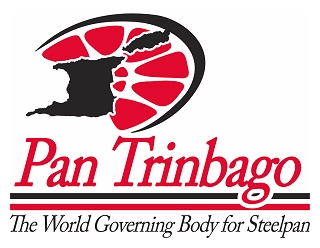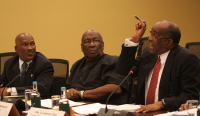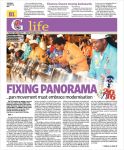"Passion, precision, percussion. The panman dedicates sleepless nights and countless hours to memorizing arrangements of calypsos for competition, the Panorama. The necessity for that element of competition in Carnival is still being debated." Photo © 1997, Cyan Studios Ltd. Excerpted from the book, Return to Kairi: A Trinidad & Tobago Journey (Port of Spain: Jett Samm Publishing, 1998)
I am a steelpan fan, not necessarily an overt steelpan junkie, but I do appreciate the music born here in Trinidad and Tobago and that sound that makes that original music. This is ours, and once a year, we can all participate in a festival that not only celebrates that sound, but reminds those who are sensitive to the subliminal signs of what steelband researcher Kim Johnson called “the audacity of creole imagination.” The annual Panorama competition has increasingly become a “must do” option for Carnival because, to me, it is more than music, it is history and individual biography, it is sociology and science, rhythm and motion, it is tonic and elixir for Carnival. It is fun. I become a “people observer” trying to create stories out of the snippets of overheard conversations, and the sights and sounds of this organised chaos that we call Trinidad Carnival.
First things first: Trinidad Carnival is not a spectator sport but a participatory event, or a series of participatory events: soca fêtes, costume masquerade, pre-dawn j'ouvert, soca and calypso competitions, and the Panorama. Panorama Finals, a celebration of and a competition among the best steelbands nationally happens in the Queens Park Savannah in Port of Spain—or the Big Yard, as we refer to it locally—on the Saturday before Carnival. It includes bands from all over the islands performing eight-minute arrangements of calypsos, although one is now more likely to hear arrangements of soca songs increasingly composed by the steelband arrangers who don't normally produce songs to compete in the hustle and bustle of carnival music.
The Panorama Final is the end of a series of gatherings that awaken a spirit that anybody can partake of. If you are in the island early enough, about 3 weeks before the Carnival days, one can do a panyard crawl to sample the sounds and sights of that urban space where late-night practice makes for a blending of musical dexterity, rote learning devoid of the fully understood theory, and wilful determination towards an oft elusive Panorama champion title. As in the football World Cup, there are just a few winners in the history of Panorama, but that has not stopped bands from all corners of the island from competing for the idea of Panorama champion. Arguments about “who play better,” and “who had more excitement in the pan”, and “that is not a tune for Panorama” resonate for months after Carnival is over. Panorama is more than music.
Panorama is music in motion. Panorama is an awakening of sensibilities that give us permission to behave badly. Music and movement and emotion all in one. The motion of the players rocking and grooving to the sound and rhythm of the engine room, the percussive centre of the steelband. The motion of the fans dancing to this music, percolating at a clip rhythm that guarantees body and tempo should become one. Dancing is inevitable. Dancing in time with the music, more so. Chipping (slow steady sliding steps as you move forward with the bands) and to a lesser extent, wining (sexy and suggestive gyrating of the hips, preferably with a partner), and jumping up (vertical with hands in the air, and in time with the music) are the dances of carnival and the dances inspired by pan music. Shoes, then, become mandatory. Slippers may work, but if pedicures are important, sneakers are better.
When you consider that the early Panorama preliminaries in the 1960s were judged “on the move”—with steelbands in racks being pushed on wheels by partisan supporters from the community—you may question whether we have gone backwards or away from our Caribbean instinct to move. Now we have bands being judged in a static formation on a stage, facing one direction, orchestra-like, in defiance to the urge to jump up. What ends are we serving, a European ideal for conformity or a Caribbean reality for participation, joy and movement? I guess the answer can be better considered depending where you are seeing and hearing the Panorama. For we do have a couple options: the drag or the stands.
The action, the real action takes place on “the drag,” a strip of tarmacadam that wends its way in and out of the Savannah passing in front of the Grand Stand, an evolution of the old horse racing grandstand. (The original was demolished in 2006 to be rebuilt as a clone in 2011). That original pavilion for Sport of Kings birthed a sister stand, the North Stand, which has become the playground of and a magnet for the imitative “mimic men” of the middle classes, pretenders looking to become one with the people. Between the drag and the North Stand, you can sense what the atmosphere of true liberation—and libation—the Panorama can be.
The North Stand is the fun place to be if you're is liming in the stands. A cacophony of rhythmic iron clanging, hand drumming and bottle and spoon beating makes for a noisy air of communal spirit and activity that one may find at an EDM festival or Glastonbury maybe. In Trinidad, rum rules, and the idea of the primacy of music is slowly giving way to the idea of a new kind of hedonism that travel writers casually describe as a selling point for Caribbean people.
All this pleasure becomes evident when you're on the drag. From this vantage point, you can hear all the bands do a final practice performance of their competition tune and it's all free. Restriction and freedom are two opposites that shaped Trinidad history. At Panorama, on the drag, they live side by side to shape what we see and hear. Food and drink, drink and food, the cuisine of the casual participant is the fuel for what seems to be an endless celebration. Time has no boundaries at Panorama. The Panorama semi-final, an important milestone in the series as this allows for a gauge of what is possible and what is really happening in steelband music is normally a 14-hour event starting before mid day!
Panorama, to some, is the apotheosis of the steelband. To others, it reflects a growing decay of the communal spirit associated with the movement and a movement. Commercialism ;and a kind of redundancy, and a number of alternative events have eaten away at some of the appeal of Panorama. But for me, it is a rekindling of hope that we are masters of our domain, not necessarily conforming to the dictates of gatekeepers that rule media and creative enterprises. It is our little rebellion. Our fantasy that for a day, after many days and nights in those panyards, those crucibles of creativity and sweat and fire, we as a nation can make something that will last the test of time. It is also our chaotic and fervent and rhythmic moment when time stands still, literally—we can all move as one to the beat.
* Originally published in the January/February 2017 issue of Caribbean Beat Magazine
© 2017, Nigel A. Campbell. All rights Reserved.

 A simple answer could be that Panorama represents the apotheosis of the national instrument. That reasoning was supplied by steelpan researcher Dr Kim Johnson, who spoke to the T&T Guardian about the idea of the continuation of the state funded event within the context of moribund standards for the industry of steelpan throughout the year. Johnson noted the history of Panorama: “Panorama was the PNM government of the 1960s taking control of the steelband movement, what they saw as national culture. The strategy included making it more lucrative to play in Panorama because of prize money and appearance fees than to play in parties and fêtes.”
A simple answer could be that Panorama represents the apotheosis of the national instrument. That reasoning was supplied by steelpan researcher Dr Kim Johnson, who spoke to the T&T Guardian about the idea of the continuation of the state funded event within the context of moribund standards for the industry of steelpan throughout the year. Johnson noted the history of Panorama: “Panorama was the PNM government of the 1960s taking control of the steelband movement, what they saw as national culture. The strategy included making it more lucrative to play in Panorama because of prize money and appearance fees than to play in parties and fêtes.” In these modern times, the State, spends millions on the continuation of Carnival both as catharsis and economic input via tourism and the economic multiplier effect of trade at that time. In 2016, $270 M
In these modern times, the State, spends millions on the continuation of Carnival both as catharsis and economic input via tourism and the economic multiplier effect of trade at that time. In 2016, $270 M 
 Kim Johnson says that “Panorama is a competition for arrangers.” However, there is a kind of stasis in the growth of prize winning arrangers. Despite the embargo on one arranger arranging for multiple bands many years ago, in the last 35 years only eight arrangers have “won” in the large band category, the late Jit Samaroo winning nine times, Leon “Smooth” Edwards winning eight times, Len “Boogsie” Sharpe winning seven times among the leaders.
Kim Johnson says that “Panorama is a competition for arrangers.” However, there is a kind of stasis in the growth of prize winning arrangers. Despite the embargo on one arranger arranging for multiple bands many years ago, in the last 35 years only eight arrangers have “won” in the large band category, the late Jit Samaroo winning nine times, Leon “Smooth” Edwards winning eight times, Len “Boogsie” Sharpe winning seven times among the leaders.